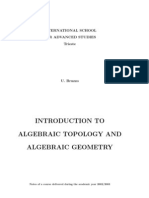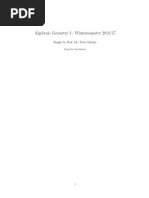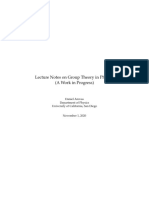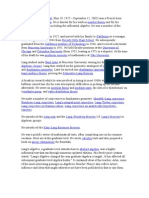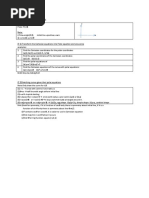Group Theory MATH10079
Uploaded by
Loh Jun XianGroup Theory MATH10079
Uploaded by
Loh Jun XianGroup Theory
MATH10079
Wednesday 28th April 2021
1300-1500 † *
† All students: you have an additional 1 hour to assemble and submit your PDF.
Final submission deadline: 16:00.
*
Students with a Schedule of Adjustment for additional time in examinations:
You are entitled to a further fixed additional 1 hour for this remote examination.
Final submission deadline: 17:00
Attempt all questions
Important instructions
1. Start each question on a new sheet of paper.
2. Number your sheets of paper to help you scan them in order.
3. Only write on one side of each piece of paper.
4. If you have rough work to do, simply include it within your overall answer – put
brackets at the start and end of it if you want to highlight that it is rough work.
MATH10079 Group Theory 1
(1) Consider the group homomorphism
φ:Z×Z→Z
(a, b) 7→ 8a − 12b.
(In this question, you may use the fact that φ is a group homomorphism without
proof.)
(a) Show that ker φ and im φ are both isomorphic to Z, and give a generator of
each. [8 marks]
ker φ
Note that (12, 8) ∈ ker φ. Let A = Z×Z
h(12,8)i
and B = h(12,8)i
, which is a subgroup of A.
(b) Show that B is cyclic and find its order. [5 marks]
(c) Use the Isomorphism Theorems to show that A/B ∼
= Z. [7 marks]
[Please turn over]
MATH10079 Group Theory 2
(2) Indicate whether the following statements are TRUE or FALSE, providing a short
(one or two sentence) justification for your answer. Clearly state any theorems that
you employ. Each answer will receive 2 marks if fully correct, 0 otherwise.
[20 marks]
(a) Z7 × Z10 is cyclic.
(b) S5 is equal to its own derived subgroup.
(c) Any group of order 77 contains a normal subgroup of order 11.
(d) There is no simple group of order 360.
(e) If two groups have the same composition factors, they are isomorphic.
(f) Any group of order 54 has a normal subgroup of order 27.
(g) Any group of order 54 has a normal subgroup of order 2.
(h) There is a group with class equation
60 = 1 + 20 + 15 + 24.
(i) There is a group G and a homomorphism φ : S3 → G with ker φ = {e, (12)}.
(j) If G is a group and H ≤ G, then the composition length of H is no bigger than
the composition length of G.
[Please turn over]
MATH10079 Group Theory 3
(3) (a) Let G = Z3 /hf1 , f2 , f3 i, where f1 = (3, 9, 6), f2 = (−3, −3, 6), f3 = (−6, −6, 0).
If possible, write G as a direct product of cyclic groups of prime power order,
clearly indicating the steps in your computation. If this is impossible, explain
why. [9 marks]
(b) (i) Up to isomorphism, how many abelian groups of order 180 are there? Give a
complete list, where each group is given as a direct product of cyclic groups
of prime power order. [4 marks]
(ii) Show that, up to isomorphism, there is a unique abelian group of order 180
which has 18 elements of order 18. Indicate which group this is on your list
from part (i). [7 marks]
[Please turn over]
MATH10079 Group Theory 4
(4) (a) Find all subgroups of Z containing 54Z and the inclusions among them. Use
the Correspondence Theorem to find all subgroups of Z/54Z and the inclusions
among them. Identify these subgroups both as explicit subgroups of Z54 (for
example, {0, 27}) and as factors of the form nZ/54Z. [10 marks]
(b) Prove that for any n ≥ 3 there is a surjective group homomorphism from the
infinite dihedral group
D∞ = ha, c|a2 , c2 i
to the dihedral group Dn . Thus show that |D∞ | = ∞.
If you wish, you may use without proof the fact that
Dn ∼
= hx, y|x2 , y 2 , (xy)n i
for any n ≥ 3. [10 marks]
[Please turn over]
MATH10079 Group Theory 5
(5) The Z-series of a group G is a series of subgroups
{e} = Z0 (G) ≤ Z1 (G) ≤ Z2 (G) ≤ · · · ≤ G.
It is defined inductively: Z0 = Z0 (G) = {e}, and
Zi+1 = Zi+1 (G) = {g ∈ G | gZi ∈ Z(G/Zi )}.
(Here recall that if H is a group, then Z(H) denotes the centre of H.) In particular,
Z1 (G) = Z(G).
(a) Notice that for this definition to make sense, G/Zi (G) must be a group; that
is, each Zi (G) must be a normal subgroup of G. Prove that Zi (G) C G for all
i. [8 marks]
(b) Find Z(D4 ) and Z(D4 /Z(D4 )). Thus calculate the Z-series of D4 . [6 marks]
(c) A group has property Z if some Zn (G) is equal to G. Prove that if G has property
Z then G is solvable. [6 marks]
[End of Paper]
You might also like
- Laboratory Studies in Integrated Principles of Zoology 18th EditionNo ratings yetLaboratory Studies in Integrated Principles of Zoology 18th Edition54 pages
- Brodmann M.P., Sharp R.Y.-local CohomologyNo ratings yetBrodmann M.P., Sharp R.Y.-local Cohomology516 pages
- (F. Buekenhout) Handbook of Incidence Geometry - BNo ratings yet(F. Buekenhout) Handbook of Incidence Geometry - B1,399 pages
- Introduction To Algebraic Topology and Algebraic Geometry - U. Bruzzo100% (1)Introduction To Algebraic Topology and Algebraic Geometry - U. Bruzzo132 pages
- Notes On Real Analysis: Lee Larson March 26, 20120% (1)Notes On Real Analysis: Lee Larson March 26, 20125 pages
- PDF Advanced Modern Algebra Part 1 3rd Edition Joseph J. Rotman Download100% (6)PDF Advanced Modern Algebra Part 1 3rd Edition Joseph J. Rotman Download52 pages
- Galois Theories by Francis Borceux, George Janelidze100% (1)Galois Theories by Francis Borceux, George Janelidze353 pages
- Several Complex Variables with Connections to Algebraic Geometry and Lie Groups 1st Edition Joseph L. Taylor 2024 Scribd Download100% (1)Several Complex Variables with Connections to Algebraic Geometry and Lie Groups 1st Edition Joseph L. Taylor 2024 Scribd Download77 pages
- Instant Ebooks Textbook Symmetrization in Analysis Albert Baernstein Ii Download All Chapters100% (12)Instant Ebooks Textbook Symmetrization in Analysis Albert Baernstein Ii Download All Chapters70 pages
- Explicit Brauer Induction: Cambridge Studies in Advanced Mathematics: 40No ratings yetExplicit Brauer Induction: Cambridge Studies in Advanced Mathematics: 40421 pages
- Stichtenoth-Algebraic Function Fields and Codes-2008100% (1)Stichtenoth-Algebraic Function Fields and Codes-2008363 pages
- Scholze - Algebraic Geometry Course NotesNo ratings yetScholze - Algebraic Geometry Course Notes110 pages
- Rami Shakarchi - Problems and Solutions For Complex Analysis (1999)No ratings yetRami Shakarchi - Problems and Solutions For Complex Analysis (1999)259 pages
- 4 Countability Axioms: Definition 4.1. Let100% (1)4 Countability Axioms: Definition 4.1. Let13 pages
- Evan Chen: Transcript of Mathematics CourseworkNo ratings yetEvan Chen: Transcript of Mathematics Coursework3 pages
- D Jubnov Seny A Subnoma Siny Oa R P A, INo ratings yetD Jubnov Seny A Subnoma Siny Oa R P A, I5 pages
- (J.W. Gardner, R. Wiegandt) Radical Theory of Ring100% (1)(J.W. Gardner, R. Wiegandt) Radical Theory of Ring408 pages
- Answers To Problems For A Course in Real Analysis by Hugo JunghennNo ratings yetAnswers To Problems For A Course in Real Analysis by Hugo Junghenn10 pages
- Mathematics 433/533 Class Notes: Richard KochNo ratings yetMathematics 433/533 Class Notes: Richard Koch188 pages
- An Invitation To General Algebra and Universal ConstructionsNo ratings yetAn Invitation To General Algebra and Universal Constructions405 pages
- Set Theory: Reading: Chapter 1 (1-17) From The TextbookNo ratings yetSet Theory: Reading: Chapter 1 (1-17) From The Textbook17 pages
- A Graduate Course in Algebra 2 by Ioannis Farmakis, Martin Moskowitz100% (2)A Graduate Course in Algebra 2 by Ioannis Farmakis, Martin Moskowitz415 pages
- 2.8. Representations and Cohomology (Volume 1, Basic Representation Theory of Finite Groups and Associative Algebras) (Dave J. Benson - (Cambridge) ) 2004No ratings yet2.8. Representations and Cohomology (Volume 1, Basic Representation Theory of Finite Groups and Associative Algebras) (Dave J. Benson - (Cambridge) ) 2004262 pages
- Fourier Analysis On Number Fields - Dinakar Ramakrishnan & Robert J. ValenzaNo ratings yetFourier Analysis On Number Fields - Dinakar Ramakrishnan & Robert J. Valenza372 pages
- D. H. Fremlin - Measure Theory, Volume 5, Part 1 (2000, Torres Fremlin) PDFNo ratings yetD. H. Fremlin - Measure Theory, Volume 5, Part 1 (2000, Torres Fremlin) PDF292 pages
- Daniel Gorenstein - The Classification of The Finite Simple Groups PDF100% (1)Daniel Gorenstein - The Classification of The Finite Simple Groups PDF176 pages
- Full Download Rings and Their Modules 1st Edition Paul E. Bland PDF100% (3)Full Download Rings and Their Modules 1st Edition Paul E. Bland PDF84 pages
- Read Online Here: Introduction To Abstract Algebra Solutions 2No ratings yetRead Online Here: Introduction To Abstract Algebra Solutions 25 pages
- Introduction To Algebraic Geometry - Dolgachev PDFNo ratings yetIntroduction To Algebraic Geometry - Dolgachev PDF198 pages
- An Overview of Patterson-Sullivan Theory: J.-F. QuintNo ratings yetAn Overview of Patterson-Sullivan Theory: J.-F. Quint52 pages
- The University of Edinburgh College of Science and EngineeringNo ratings yetThe University of Edinburgh College of Science and Engineering3 pages
- Problem Sheet 1 (For Tutorials in Week 3)No ratings yetProblem Sheet 1 (For Tutorials in Week 3)2 pages
- The University of Edinburgh College of Science and EngineeringNo ratings yetThe University of Edinburgh College of Science and Engineering5 pages
- Essential Calculus. Early Transcendentals Formulae Booklet 2No ratings yetEssential Calculus. Early Transcendentals Formulae Booklet 210 pages
- The University of Edinburgh College of Science and EngineeringNo ratings yetThe University of Edinburgh College of Science and Engineering13 pages
- Accelerated Algebra and Calculus For Direct Entry 2015No ratings yetAccelerated Algebra and Calculus For Direct Entry 201517 pages
- Problem Sheet 2 (For Tutorials in Week 4)No ratings yetProblem Sheet 2 (For Tutorials in Week 4)2 pages
- Climate Protection and Environmental Interests in Renewable Energy Law: Perspectives From Brazil and Germany Paula Galbiatti Silveira100% (2)Climate Protection and Environmental Interests in Renewable Energy Law: Perspectives From Brazil and Germany Paula Galbiatti Silveira49 pages
- Why Social Justice Matters 1st Edition Brian Barry all chapter instant download100% (4)Why Social Justice Matters 1st Edition Brian Barry all chapter instant download61 pages
- Tirumala Cotton Recruitment and Selection Recruitment and Selection RCENo ratings yetTirumala Cotton Recruitment and Selection Recruitment and Selection RCE71 pages
- Corporate and Business Law (LW-ENG) : Syllabus and Study GuideNo ratings yetCorporate and Business Law (LW-ENG) : Syllabus and Study Guide15 pages
- Infection Prevention and Control (IPC) For COVID-19 VirusNo ratings yetInfection Prevention and Control (IPC) For COVID-19 Virus21 pages
- Business Strategies & Their Marketing Implications: By: DR Shahinaz AbdellatifNo ratings yetBusiness Strategies & Their Marketing Implications: By: DR Shahinaz Abdellatif22 pages
- The Management of Productivity and Technology in Manufacturing PDF100% (2)The Management of Productivity and Technology in Manufacturing PDF333 pages
- Brand Awareness & Preference Regarding Havells Green CFL PDF100% (1)Brand Awareness & Preference Regarding Havells Green CFL PDF74 pages
- Marine Pumps: Grundfos Industrial Solutions Marine100% (1)Marine Pumps: Grundfos Industrial Solutions Marine7 pages
- The Present Perfect Tense and Past PerfectNo ratings yetThe Present Perfect Tense and Past Perfect5 pages
- Laboratory Studies in Integrated Principles of Zoology 18th EditionLaboratory Studies in Integrated Principles of Zoology 18th Edition
- (F. Buekenhout) Handbook of Incidence Geometry - B(F. Buekenhout) Handbook of Incidence Geometry - B
- Introduction To Algebraic Topology and Algebraic Geometry - U. BruzzoIntroduction To Algebraic Topology and Algebraic Geometry - U. Bruzzo
- PDF Advanced Modern Algebra Part 1 3rd Edition Joseph J. Rotman DownloadPDF Advanced Modern Algebra Part 1 3rd Edition Joseph J. Rotman Download
- Galois Theories by Francis Borceux, George JanelidzeGalois Theories by Francis Borceux, George Janelidze
- Several Complex Variables with Connections to Algebraic Geometry and Lie Groups 1st Edition Joseph L. Taylor 2024 Scribd DownloadSeveral Complex Variables with Connections to Algebraic Geometry and Lie Groups 1st Edition Joseph L. Taylor 2024 Scribd Download
- Instant Ebooks Textbook Symmetrization in Analysis Albert Baernstein Ii Download All ChaptersInstant Ebooks Textbook Symmetrization in Analysis Albert Baernstein Ii Download All Chapters
- Explicit Brauer Induction: Cambridge Studies in Advanced Mathematics: 40Explicit Brauer Induction: Cambridge Studies in Advanced Mathematics: 40
- Stichtenoth-Algebraic Function Fields and Codes-2008Stichtenoth-Algebraic Function Fields and Codes-2008
- Rami Shakarchi - Problems and Solutions For Complex Analysis (1999)Rami Shakarchi - Problems and Solutions For Complex Analysis (1999)
- (J.W. Gardner, R. Wiegandt) Radical Theory of Ring(J.W. Gardner, R. Wiegandt) Radical Theory of Ring
- Answers To Problems For A Course in Real Analysis by Hugo JunghennAnswers To Problems For A Course in Real Analysis by Hugo Junghenn
- An Invitation To General Algebra and Universal ConstructionsAn Invitation To General Algebra and Universal Constructions
- Set Theory: Reading: Chapter 1 (1-17) From The TextbookSet Theory: Reading: Chapter 1 (1-17) From The Textbook
- A Graduate Course in Algebra 2 by Ioannis Farmakis, Martin MoskowitzA Graduate Course in Algebra 2 by Ioannis Farmakis, Martin Moskowitz
- 2.8. Representations and Cohomology (Volume 1, Basic Representation Theory of Finite Groups and Associative Algebras) (Dave J. Benson - (Cambridge) ) 20042.8. Representations and Cohomology (Volume 1, Basic Representation Theory of Finite Groups and Associative Algebras) (Dave J. Benson - (Cambridge) ) 2004
- Fourier Analysis On Number Fields - Dinakar Ramakrishnan & Robert J. ValenzaFourier Analysis On Number Fields - Dinakar Ramakrishnan & Robert J. Valenza
- D. H. Fremlin - Measure Theory, Volume 5, Part 1 (2000, Torres Fremlin) PDFD. H. Fremlin - Measure Theory, Volume 5, Part 1 (2000, Torres Fremlin) PDF
- Daniel Gorenstein - The Classification of The Finite Simple Groups PDFDaniel Gorenstein - The Classification of The Finite Simple Groups PDF
- Full Download Rings and Their Modules 1st Edition Paul E. Bland PDFFull Download Rings and Their Modules 1st Edition Paul E. Bland PDF
- Read Online Here: Introduction To Abstract Algebra Solutions 2Read Online Here: Introduction To Abstract Algebra Solutions 2
- Introduction To Algebraic Geometry - Dolgachev PDFIntroduction To Algebraic Geometry - Dolgachev PDF
- An Overview of Patterson-Sullivan Theory: J.-F. QuintAn Overview of Patterson-Sullivan Theory: J.-F. Quint
- An Introduction to Metric Spaces and Fixed Point TheoryFrom EverandAn Introduction to Metric Spaces and Fixed Point Theory
- Generalized Functions and Partial Differential EquationsFrom EverandGeneralized Functions and Partial Differential Equations
- Fibonacci and Catalan Numbers: An IntroductionFrom EverandFibonacci and Catalan Numbers: An Introduction
- Lebesgue Measure and Integration: An IntroductionFrom EverandLebesgue Measure and Integration: An Introduction
- Applications of Model Theory to Functional AnalysisFrom EverandApplications of Model Theory to Functional Analysis
- The University of Edinburgh College of Science and EngineeringThe University of Edinburgh College of Science and Engineering
- The University of Edinburgh College of Science and EngineeringThe University of Edinburgh College of Science and Engineering
- Essential Calculus. Early Transcendentals Formulae Booklet 2Essential Calculus. Early Transcendentals Formulae Booklet 2
- The University of Edinburgh College of Science and EngineeringThe University of Edinburgh College of Science and Engineering
- Accelerated Algebra and Calculus For Direct Entry 2015Accelerated Algebra and Calculus For Direct Entry 2015
- Climate Protection and Environmental Interests in Renewable Energy Law: Perspectives From Brazil and Germany Paula Galbiatti SilveiraClimate Protection and Environmental Interests in Renewable Energy Law: Perspectives From Brazil and Germany Paula Galbiatti Silveira
- Why Social Justice Matters 1st Edition Brian Barry all chapter instant downloadWhy Social Justice Matters 1st Edition Brian Barry all chapter instant download
- Tirumala Cotton Recruitment and Selection Recruitment and Selection RCETirumala Cotton Recruitment and Selection Recruitment and Selection RCE
- Corporate and Business Law (LW-ENG) : Syllabus and Study GuideCorporate and Business Law (LW-ENG) : Syllabus and Study Guide
- Infection Prevention and Control (IPC) For COVID-19 VirusInfection Prevention and Control (IPC) For COVID-19 Virus
- Business Strategies & Their Marketing Implications: By: DR Shahinaz AbdellatifBusiness Strategies & Their Marketing Implications: By: DR Shahinaz Abdellatif
- The Management of Productivity and Technology in Manufacturing PDFThe Management of Productivity and Technology in Manufacturing PDF
- Brand Awareness & Preference Regarding Havells Green CFL PDFBrand Awareness & Preference Regarding Havells Green CFL PDF
- Marine Pumps: Grundfos Industrial Solutions MarineMarine Pumps: Grundfos Industrial Solutions Marine





